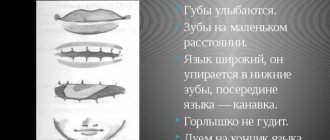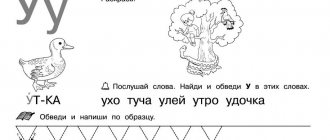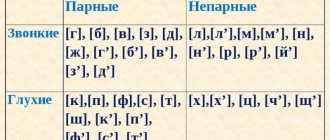Readers of our regular phonetic column have more than once asked in the comments to understand the interdental sound th. This is not at all surprising: th is one of the most frequently encountered sounds in the English language, while in Russian (and in many others) this sound simply does not exist.
How to pronounce it? How to fix common mistakes? How to “train your mouth” to pronounce correctly? Today we will answer these questions using videos, exercises, tongue twisters, words and examples from songs.
What sound do the letters th make?
Just let’s make it clear right away that th is not a sound. This is a combination of letters that can be read as two sounds: voiceless / θ /, as in the word thanks,
and voiced /ð/, as in
that.
It is with these signs that the interdental “th sounds” are indicated in transcription. But in the article I will sometimes write “th sound” for convenience.
Both sounds, voiced and unvoiced, are articulated in the same way (lips and tongue are in the same position). Therefore, we will structure the work as follows:
- First, let's learn the correct mouth position for both sounds;
- Then we will analyze possible errors and find out how to correct them;
- Then we will work on tongue twisters and words, each sound separately.
Text of the book “I want to speak beautifully! Speech techniques. Communication techniques"
Diction
The basis of good diction is the clear and energetic work of all muscles involved in the speech process.
The presented exercises will help you develop and maintain the elasticity and mobility of the speech apparatus. Before you begin training the correct pronunciation of vowels and consonants, you need to warm up your speech apparatus.
The speech apparatus includes: lips, tongue, jaws, teeth, hard and soft palate, small tongue, larynx, posterior wall of the pharynx (pharynx), vocal cords. Some of them passively participate in speech, while others, such as the tongue, lips, soft palate, small uvula and lower jaw, take an active part, so they can and should be trained.
Exercise
1. Opening the mouth. The first condition for clear, clear speech is a free and well-opening mouth. Starting position – mouth closed, lips and jaws relaxed, tongue lying flat, freely touching the lower front teeth.
Say the sound [U] several times without effort or tension: uuuuu. Now pronounce the sound [A], open your mouth vertically, lower your lower jaw by about two fingers (≈ 3 cm). You need to open your mouth at [A] with soft, slow movements. Do this 5-6 times.
Exercise
2. Show your teeth. Starting position – mouth closed, jaws clenched. At the same time, lift your upper lip and pull back your lower lip, exposing your upper and lower teeth. Do this 5-6 times.
Exercise
3. Stretching the lips - “proboscis”. Starting position – the mouth is closed, the jaws are clenched, motionless, the lips are “in the proboscis” (sound [U]). Make turns of the “proboscis” to the right, left, down, up), then in a circle - to the right, to the left. Repeat 3-4 times.
Exercise
4. "Sliding". Starting position – mouth half open. At the same time, pull your upper and lower lips over your teeth, then with a smooth, sliding movement, open your lips “to smile.” Repeat 5-6 times.
Exercise
5. Language training. Starting position – the tongue is placed in a “tray” in the mouth, the tip of the tongue touches the lower teeth, the mouth is open two fingers (≈ 3 cm), the lower jaw is absolutely motionless. Lift the tip of the tongue up - to the hard palate, then to the right, to the left - to the cheek and return to its original position again. Repeat 4 times.
At first, do all exercises with a mirror; movements should be slow and smooth. If some exercises don't work out, don't be discouraged, just repeat them over and over again.
After you have warmed up the muscles of the speech apparatus, you can begin articulatory gymnastics. The goal is to develop a clear, clear, correct sound of each vowel and consonant sound. The training begins with vowel sounds, the correct pronunciation of which gives sonority and melody to our speech, while consonant sounds are like a backbone, a framework.
SO, PRACTICE VOWEL SOUNDS
When pronouncing vowels, air passes freely through the oral cavity without encountering obstacles; only the position of the lips and tongue changes. There are six basic vowel sounds: I, E, A, O, U, Y. The letters E, I, Yu, E indicate iotized sounds. This means that two letters are involved in the sound of these vowels, where the first letter Y, as it were, softens the second letter pronounced together with it.
For example, the letter E is pronounced as YEE, hear, the ending of the sound becomes similar to the sound E, respectively: jA, jU, jO.
As a rule, there are no difficulties in pronouncing vowels. The speech apparatus, lips in particular, simply influence the different colors in the pronunciation of these vowels I, E, A, O, U, Y.
An exercise to train the pronunciation of vowel sounds.
Say the vowels slowly, but in one breath, or rather in one exhalation, in the following sequence.
I-E-A-O-U-Y
Try to more actively use all the muscles of the speech apparatus. I would even say with some effort, so that when you look at yourself in the mirror, you see a kind of grimace. This will warm up your speech apparatus well and in a relaxed state the sound will remain just as bright. Gradually speed up the pace. Try to say several connectives in one breath. But make sure that this does not harm the sound. All sounds must be clearly audible.
When you can pronounce this bundle confidently and quickly enough, move on to the bundle with iotated vowels. All the same. First E-Y-Y-Yo slowly then quickly. Then connect the two ligaments I-E-A-O-U-Y – E-YU-YA-YO. And do it again in the same rhythm: from slow to fast.
Once you get it sounding good, try saying different words that start with vowels. For example, morning, skirt, echo, spruce, willow, son, wasps, tree, act, yar
Practicing the pronunciation of consonant sounds.
When pronouncing consonants, greater tension in the speech apparatus is required than when pronouncing vowels. Working on consonants requires more attention because deficiencies in their pronunciation are much more common.
Practicing consonant sounds [B]–[P]
The sounds [B] and [P] are paired, explosive. The sound [P] is dull and is pronounced only by the noise of exhaled air, without a voice, and the sound [B] is voiced and is pronounced with a voice.
Say one by one several times: b-p, b-p, b-p, b-p, b-p, b-p, b-p, etc.
And now we will practice the pronunciation of these sounds with all the vowels of the table I-E-A-O-U-Y-E-Y-Y-YU. The proposed exercises follow the principle of simultaneous training of diction, breathing and voice. If you feel that it is difficult for you to do complex exercises, do not do them now, but return to them after more simple ones.
The exercise scheme is the same for practicing the consonant sounds PB TD KGFV and the sound X. Write it down.
Perform each exercise on one exhalation; if it is difficult, then do more air.
Exercise
1. Bi, be, ba, bo, bu, by, be, bya, byo, byu.
Exercise
2. Bee-bee, bee-bee, ba-ba, bo-bo, boo-boo, would-be, be-be, bya-bya, byo-bye, bye-bye.
Exercise
3. Bee-bee-bee, bee-bee-bee, ba-ba-ba, bo-bo-bo, boo-boo-boo, would-be-be, be-be-be, bya-bya-bya, Byo-byo-byo, by-by-by-by.
Exercise
4. Bee-bee-bee-bee, bee-bee-bee, ba-ba-ba-ba, bo-bo-bo-bo, boo-boo-boo-boo, would-be-would-be, be-be-be-be, bya-bya-bya-bya, byo-bye-bye-bye, bye-bye-bye-bye.
Exercise
5. Beep, bap, bap, bop, boop, bep, bep, bap, bep, bap.
Exercise
6. Be-beep, be-bap, ba-bap, bo-bop, boo-boop, be-byp, be-bap, by-byap, be-byop, by-byup.
Exercise
7. Bee-be-beep, be-be-bap, ba-ba-bap, bo-bo-bop, boo-boo-boop, be-be-bep, be-be-bep, bya-bya-byap, byo-byo-byop, byo-byo-byup.
Exercise
8. Bee-be-be-beep, be-be-be-bap, ba-ba-ba-bap, bo-bo-bo-bop, boo-bu-bu-boop, would-be-would-be, be-be-be-bep, be-by-by-by-byap, be-by-by-by-byop, by-by-by-by-byup.
Do the same exercises, but with the sound P. Replace the sound B with P and, accordingly, at the end you change the sound P with B.
Exercise 1. Pi, pe, pa, po, pu, py, pe, pya, pyo, pyu.
Exercise 2. Everything is the same according to the above scheme from exercises 1 to 8.
Now we are working with double sound. The double sound is pronounced as one assertive sound. Place the emphasis on the first syllable.
Exercise scheme.
Exercise
1. B
and
ppi, b
e
ppe, b
a
ppa, b
o
ppo, b
u
ppu, b
y
ppy, b
e
ppe, b i p pya
, b
e p
pyo , b
u
p pyu.
Exercise
2. Bi-b
and
ppi, be-b
e
ppe, ba-b
a
ppa, bo-b
o
ppo, bu-b
u
ppu, b-b
y
ppa, be-
e
ppe, bya-b
i
ppa and etc.
Exercise
3. Bee-be-b
and
ppi, be-be-b
e
ppe, ba-ba-b
a
ppa, bo-bo-b
o
ppo, bu-bu-b
u
ppu, would-be-b
y
ppy and etc.
Exercise
4. Bee-pibby, be-pebbe, ba-pubba, bo-pobbo, boo-pubbu, be-pibby, be-pebbe, etc.
Exercise
5. Bee-bee-pibby, be-be-pebbe, ba-ba-pubba, bo-bo-pobbo, boo-bu-pubbu, would-be-pibby, etc.
Do the same exercises, but with the sound P. Replace the sound B with P. Everything is the same according to the above scheme from the 1st to the 5th exercise.
Exercise 1. P and
bbi, p
e
bbe, p
a
bba, p
o
bbo, p
u
bbu, p
y
bby, etc. according to the scheme
When training, keep your palm on the diaphragm and watch the exhalation.
Limit the number of exercises to repeat based on your individual characteristics.
You can also use tongue twisters to practice sounds B - P.
1. The bull was stupid, the bull was stupid, the bull had a white lip, it was stupid - stupid - stupid.
2. There is a priest on a head, a cap on the priest, a head under the priest, a priest under a cap.
3. All hogs are kind to their beavers.
4. The parrot said to the parrot: “I’ll parrot you, parrot.” The parrot answers him: “Parrot, parrot, parrot!”
Read slowly several times until you feel like you can read the tongue twister slowly without stuttering. Then read the tongue twister as fast as you normally speak. Make sure you can pronounce the text confidently. Increase your speed. And now even more. Now say the tongue twister to the best of your ability. It turns out?
Practicing the pronunciation of consonant sounds T – D
Consonant sounds [T] and [D] are paired, voiceless and voiced, plosive.
To clearly distinguish the difference between a voiceless and a voiced consonant, say t-d, t-d, t-d, t-d, t-d, t-d, t-d several times alternately.
Do the exercises according to the scheme that we used above, and which, I hope, you wrote down on paper for clarity. Do each exercise with one exhalation, while watching the movement of the diaphragm, placing your palm on your stomach.
Tongue twisters for sounds T and D
1. A weaver weaves fabrics for Tanya scarves.
2. From the clatter of hooves, dust flies across the field.
3. There is firewood in the yard, firewood behind the yard, firewood under the yard, firewood above the yard, firewood along the yard, firewood in the width of the yard, the yard will not accommodate firewood. Take the firewood back to the wood yard!
Practicing the pronunciation of consonant sounds K – G and the sound X
Say alternately k-g, k-g, k-g, k-g, k-g, k-g, k-g
And complete the Exercises according to the proposed scheme.
Tongue Twisters
1. The Christmas tree has pins.
2. The cuckoo bought a hood. Put on the cuckoo's hood. How funny he is in the hood!
3. Prokop came - the dill was boiling, Prokop left - the dill was boiling, just as under Prokop the dill was boiling, so without Prokop the dill was boiling.
4. Get up, Arkhip, the rooster is hoarse.
Practicing the pronunciation of consonant sounds F – V
To clearly distinguish between a voiced and a voiceless consonant, pronounce the sounds several times in turn: f-v, f-v, f-v, f-v, f-v, f-v, f-v.
Next, perform the exercises according to the scheme
Tongue Twisters:
1. The pharaohs' favorite was replaced by sapphire and jade.
2. The water carrier was carrying water from the water supply.
Now let's do more complex exercises for pronouncing a combination of several consonants
, on which you will consolidate the material covered. Say each exercise on one exhalation.
Be sure to write down the exercise plan.
Exercise
1. Gbdi, gbde, gbda, gbdo, gbdu, gbdy, gbde, gbda, gbde, gbdy.
Exercise
2. Bdgy, bdge, bdga, bdgo, bdgu, bdgy, bdge, bdgy, bdgy, bdgy.
Exercise
3. Where, where, where, where, where, where, where, where, where, where.
Exercise
4. Kpty, kpte, kpta, kpto, kptu, kpty, kpte, kptya, kptyo, kpty.
Exercise
5 Ptky, ptke, ptka, ptko, ptku, ptke, pgkya, ptky, ptkyo, ptkyu.
Exercise
6. Ftki, ftke, ftka, ftko, ftka, ftky, ftke, ftkya, ftkyo, ftkyu.
Practicing consonants M, N, L and R
Repeat each next exercise out loud on one exhalation (If the line is long, add more air).
Scheme for training the sounds M, N, L and R
Exercise
1. Mi, me, ma, mo, mu, we, me, my, my, mu.
Exercise 2
Mi-mi-mi-mi-mi, me-me-me-me-me, ma-ma-ma-ma-ma, mo-mo-mo-mo-mo, mu-mu-mu-mu-mu, we-we-we-we-we
Exercise
3. Mimi-m
and
mmi, meme-m
e
, mom-m
a
mma, momo-m
u
mmu, we-m-
s
mmy
, meme-m
e
mme, mummy-m
I
mmya, mmyo-m
yo
mmyo, myumyu-m
yu
mmyu.
Exercise
4. Mimimim, mememem, mamamam, momomom, mumumum, washed.
Exercise
5. Mli-mla-mla-mlo-mlu-mly-mla-blah-mla-mly.
Exercise
6. Mrli-mrle-mrla-mrlo-mrlu-mrly-mrle-mrly-mrle-mrly.
The same exercises for the sounds N, L and R
Tongue Twisters
1. Malanya the chatterbox chattered and blurted out the milk, but didn’t blurt it out.
2. Karl stole corals from Clara, and Clara stole a clarinet from Karl. If Karl had not stolen corals from Clara, then Clara would not have stolen the clarinet from Karl.
Whistling and hissing consonant sounds S, Z, Sh, Zh, Ch', Shch', Ts
These sounds are the most disadvantaged in oral speech. Their pronunciation defects are as follows: lisp, lisping, whistling. These defects are caused by laxity of the tongue muscles or habits ingrained from childhood and can be eliminated with the help of training exercises.
Consonant sounds S – Z
Exercise
1. Si, se, sa, so, su, sy, se, xia, se, siu.
Exercise
2. Zee, zee, za, zo, zu, zee, zee, zee, zee, zee.
Exercise
3. Si-si, se-se, sa-sa, so-so, su-su, sy-sy, se-se...
Exercise
4. Si-si-si-si, se-se-se-se, sa-sa-sa-sa, so-so-so-so, su-su-su-su, sy-sy-sy-sy...
Exercise
5. Si-zis, se-zes, sa-zas, so-zos, su-zus, sy-zys, se-zes...
Exercise
6. Sizzy, sezze, sazza, sozzo, suzzu, syzza, sezze, syazzya, sozzo...
Exercise
7. Zissi, zesse, zassa, zosso, zussu, zyssy
Now add the consonants D, T B P G KV F R L N
It will work out
Ste, ste, hundred, hundred, stu, sti, ste, ste, ste, stu.
And accordingly, here, here, here, here, here, here, here, here, here, here. And by analogy further
Tongue Twisters.
1. Sasha walked along the highway and sucked on a dryer.
2. Watermelons were being reloaded from body to body. During a thunderstorm, the body fell apart in the mud from a load of watermelons
Practicing the consonants Ш and Ж
To distinguish between a voiceless and a voiced consonant, say alternately: sh-zh, sh-zh
The exercise scheme is the same.
Tongue Twisters.
1. In the hut, a yellow dervish from Algeria rustles with silks and, juggling with knives, eats a piece of fig.
Practicing the pronunciation of consonants Ch', Shch', C
Perform exercises for these sounds in the same way according to the scheme
Tongue Twisters
1. Scales on a pike, bristles on a pig.
2. The heron wasted away, the heron was dry, the heron was dead.
It takes a certain amount of courage and willingness to make significant changes in your speech and voice. If you have made this decision, you deserve every admiration. Because changing your speech takes time and patience. The result can become noticeable only after several months of hard work.
Orthoepy
Orthoepy covers the following sections: stress; norms of pronunciation of individual sounds and their combinations; intonation and melodic structure of speech.
We often have a question: where to put the emphasis, on which syllable? The French, for example, always place the stress on the last syllable of a word. In the Russian language, the stress is not only variable, that is, it can fall on any syllable, but it is also flexible and when the grammatical form of the same word changes, the stress changes place. For example, in the words “city”, “gorod-du”, but “gorodam”, “city” or “accepted”, “will accept”, “will accept”, but “accepted”, “will accept”.
Sometimes we hear “ringing” instead of “ringing”. It is correct to say “alphabet”, “agreement”, “sentence”, “quarter”, “catalog”, “obituary”, etc.
If you have any doubt about where to put the emphasis in a word, you should consult a dictionary .
Zhegova
People from different regions of our country often speak local dialects and dialects. There are “cursing” and “acacing” dialects. In Moscow, the Moscow region and the central regions of the country, “acquainting” is moderate. This moderate “akan” became the norm of pronunciation.
In orthoepy there is a law of reduction. Reduction is a weakening of the articulation of vowels. In an unstressed position, vowels are reduced, that is, they undergo weakened articulation and are not pronounced so clearly and clearly. Vowel sounds are pronounced without change only under stress. For example, milk. Of the three vowels of this word, only O, which is under stress, is pronounced without change. The sound O, which is closer to the shock sound, changes and is pronounced as something between A and O, let's denote it as A
. And finally, the sound O, which is in second place from the stressed O, also changes and is pronounced as something between Y and A, it is pronounced quickly, as if “eaten,” let’s designate such a sound as Y. Now try to write on paper first, replacing the vowels with orthoepic ones. It turned out to be spelled SOAP, first say it slowly and then say it quickly MILK
If a word has vowels that are in the 3rd and 4th place before the stress, then they also change to the sound Y. For example, warrior.
All sounds behind the percussion are reduced to Y. For example, hoYhoAtushki.
If the unstressed sound O is at the beginning of a word, then it is always pronounced as A.
For example, o[ a
]window, o [
a
]na, o [
a
] mistake [
ъ
], o [
a
] laziness.
In orthoepy, there is a rule according to which the voiced consonants B, V, G, D, Zh, 3 at the end of a word sound like the paired voiceless ones P, F, K, T, Sh, S. For example: forehead - lop, blood - krof, eye - eye[s], ice - fly[t], fright - fright[k].
In orthoepy, the combinations ЗЗ and Жж, located inside the root of the word, are pronounced as a long (double) soft sound Zh. For example: I’m leaving - I’m leaving, I’m coming - I’m coming, later - pozhzhe, reins - reins, rattling - rattling. The word “rain” is pronounced with a long soft [SH] (SHSH) or with a long soft [ZH] (ZHZH) instead of the combination ZhZh: dosh, dozhzha, dozzhichek, dozzhem, dozzhevik.
Combinations of MF and ZCH are pronounced as a long soft sound [Ш']: happiness - happiness, account - schet, customer - customer.
In some combinations of several consonants, one of them falls out: hello - hello, heart - heart, sun - sun.
There are a lot of rules in orthoepy and to master them you should consult the relevant literature.
6. Intonation and expressive means of speech. Working with speech text
It is very important to learn how to work with intonation in the text. If you have any kind of public speaking, be it a small presentation or a speech in front of a large audience, it is always important to rehearse your speech and make intonation accents in it. Of course, we mostly use natural conversational intonation. But when speaking in public, it is better not to improvise, but to carefully prepare for the speech.
So, LOGICAL PAUSE and LOGICAL STRESS.
Each sentence of spoken speech is divided according to its meaning into parts consisting of several words or even one word.
Such semantic groups within a sentence are called speech beats. In oral speech, each speech beat is separated from the other by stops of varying durations, the so-called logical pauses.
Pauses can coincide with punctuation marks - grammatical pauses, but they can also occur where there are no punctuation marks.
Logical (or semantic) stress
- this is the basis of thought. It highlights the main word in a phrase or group of words in a sentence. Logical accents are placed depending on the purpose of the statement, the main idea of the entire topic and group of words. For example: “The light was turned off”, “the light was turned off”. The word on which logical stress is placed is strengthened by raising or lowering the tone - tonal stress. Changing the pitch helps enhance the meaning of a word and its connection to others. This makes it possible to perceive our speech more clearly. Monotonous speech is always tiresome for listeners.
Now let's briefly talk about PUNCTION MARKS.
Signs always indicate the need to raise or lower the voice on stressed words preceding the sign. These changes in voice pitch give intonation variety to our speech. Punctuation marks most often coincide with logical pauses, and each of them has its own mandatory intonation.
Dot
indicates the completion of a thought and the completeness of a sentence. Intonation at the dot is associated with a strong lowering of the voice. Speech teachers say: “put your voice on the bottom.”
Semicolon
denotes a connecting pause, but shorter than with a pause on a point, connecting parts of one description into a single whole.
Comma
indicates that the thought is not completed, and there is a slight increase in voice. In speech, a comma means a connecting logical pause.
Colon
in oral speech it means a connecting logical pause and usually indicates the intention to list, clarify, clarify what was said before it. The voice at the colon remains on one note.
Brackets
. In spoken speech, words in brackets are pronounced faster than the main text and are surrounded on both sides by logical connecting pauses. Before the brackets, the voice rises on the preceding stressed word, then throughout the brackets it decreases, and the words are pronounced at the same pitch somewhat monotonously and, after closing the brackets, the voice returns to the same pitch that was before the start of the brackets.
Question mark
conveyed by raising the voice on the stressed word of a question sentence. If the stressed word is at the end of the sentence, then the voice goes up and stays at the top. If the stressed word is at the beginning or in the middle of a sentence, then after raising the voice on this stressed word, all other words go down. When a sentence contains several stressed question words, the voice usually rises most strongly on the last stressed word at the end of the sentence.
Exclamation mark
conveys a strong feeling (demand, praise, accusation, threat, admiration, order) and is accompanied by a strong rise in voice on the stressed word; the voice goes up and then drops sharply down.
Ellipsis
. In oral speech, the voice on the stressed word preceding the ellipsis is lowered; An ellipsis denotes something left unsaid, unsaid, implied, or an interrupted thought.
Working with speech text.
In addition to pauses, which set the rhythm of oral speech and attract the attention of listeners, there are other means of modeling speech, such as tone, volume and tempo.
A good voice has slight changes in tone. Intonation is the “rise” and “fall” of the voice. Monotony is tiresome to the ear, as a constant tone uses the same pitch. However, by changing the tone, you can completely change the meaning of words. Tone and voice reveal information about the interlocutor. In the voice and its tone we can hear timidity, ingratiation, flattery, arrogance, or confidence, cordiality, tenderness, love and much more. It all depends on your inner mood and state. By working on your tone and voice, you can learn to “not skip” negative information and add positive information. This will help you achieve the desired result in a conversation or public speech.
Take any classic piece. Please read the text carefully. Think about what voice and tone you should use to read each sentence. Consider modeling your reading volume. Which words should be emphasized in a louder voice and why? Place intonation pauses. Now, read the text as expressively as possible by recording the text reading on audio media. Listen to the recording and analyze the shortcomings of your articulation, diction, voice and tone. Read the text again, trying to eliminate any shortcomings.
Now take any newspaper article. And analyze the text in the same way. Look at how in this text you need to work with tone, volume, tempo, where, in your opinion, should logical stress and intonation pauses be placed and why? Record the reading of the text on audio media, listen, and after eliminating errors, read the text out loud again and make an audio recording.
To make your speech expressive, try to visualize what you are talking about. Bring a lively note to your pronunciation, to the sounds of your voice; bring feeling and color to your speech.
And lastly,
A beautiful and sonorous voice, clear diction, correct speech, and varied intonation - all these qualities will make your speech bright and expressive. Train! Train constantly! Try to pay more attention to your speech. And remember your speech is a reflection of your personality. Therefore, your speech should be as beautiful as you are! Good luck and prosperity to you!
Pronunciation of the th sound in English
Yes, we don't have these sounds. But we have the concept of “lisp.” Do you remember Sid the sloth from Ice Age: “No, I f
Is
anyone
young
enough
to die!” In the English dictionary, the word “lisp” (lisp) is interpreted as “a speech defect in which s and z sound like th in think and this, respectively.”
This video talks about lisps. I recommend watching: simple and humorous.
That is, it turns out that we need to pronounce Russian / s / with a lisp for the deaf / θ / and Russian / z / for the voiced / ð /. What do you mean, “lisp”? Say the word “composition” right now. When pronouncing the /c/ sound, your tongue is BEHIND your teeth. Now place your tongue between your teeth (the th sound is interdental) and say “composition” again. You will end up with something like a deaf th, as in the word thick.
Now do the same, but with the word “gap”. As a result, you will get something similar to a voiced th, as in the word then.
Why do I say “similarity”? Because Russian /s – z/ are not identical to English /s – z/, which means their lisp will be slightly different. Therefore, let’s take a closer look at the position of the articulatory apparatus.
How to pronounce th sound in English
Tongue spread out
and tense, and its tip is located between the upper and lower teeth, forming a narrow flat gap between
the cutting edge of the upper teeth
and the surface of the anterior edge of the tongue.
To learn the ideal positioning of the articulatory apparatus, I suggest you watch the video. It shows three life hacks:
2:08 – how to put the articulatory apparatus in the ideal position: open your mouth, place your tongue on top of your lower teeth so that the tip is directly behind the lower lip and slowly lower your upper teeth onto your tongue – try to pronounce the voiceless version of th, as in think
.
2:52 - how to feel the necessary tension on the tongue: take a straw and place it between the tongue and the upper teeth - this way you will feel how strong the tension should be on the tongue.
3:36 – how far to stick your tongue forward: place your finger perpendicular to your lips (as when we ask you to be quieter) and stick your tongue out. The tongue should lightly touch the finger - this is the limit.
And don’t forget to repeat sentences and words after the presenter! This sound takes practice and more practice.
Pronunciation of the interdental sound th: video.
Exercises for making sounds K, G and X
Description of correct articulation of sounds
The mouth is slightly open. Lips in a slight smile. The tip of the tongue is lowered and moved away from the lower incisors into the mouth. The back of the tongue is arched upward and its upper surface (back) closes with the palate.
In order to develop the correct articulation of these sounds, you need to teach the child to make a slight smile, and arch his wide tongue and push it inside the oral cavity as deeply as possible.
Next, articulation exercises are proposed to help develop this articulatory posture.
Proboscis-smile
(dynamic articulation exercise) Show your child how to stretch his lips forward with his proboscis (as in an exaggerated pronunciation of the sound U), and then stretch them into a wide smile so that closed teeth are visible. Hold each articulatory pose for 2-3 seconds. Invite your child to repeat the exercise.
Perform the movements counting: “One-two, one-two...”, at a calm pace. Repeat the movement 6-10 times.
Spatula
(static articulation exercise)
Show your child how to open his mouth and place a wide, relaxed tongue on his lower lip. You need to hold your tongue in this position for 5-10 seconds. Then remove your tongue and close your mouth. If the child’s tongue is too tense and does not lie calmly on the lip, then you can lightly tap it with your index finger, using a relaxing self-massage technique. Repeat the exercise 3—5
once.
Spatula - needle
(dynamic articulation exercise)
Show your child how the tongue can change shape. First, place a wide, relaxed tongue on your lower lip (“Shovel” pose). Hold your tongue in this position for 3—5
seconds Then tense your tongue and, pushing it forward, give it a pointed shape, reminiscent of a sting (the “Needle” pose).
Hold your tongue in this position for 3 - 5 seconds, then relax again, giving the shape of a shoulder blade.
Ask your child to repeat this exercise, depicting either a “Spatula” or a “Needle” several times in a row.
Cleaning the lower teeth
(dynamic articulation exercise)
Encourage your child to brush their bottom teeth with their tongue. To do this, you need to open your mouth and stroke the lower incisor teeth from the inside with the wide tip of your tongue. Movements of the tongue should be made up and down, at a calm pace, 6-10 times.
Swing
(dynamic articulation exercise)
Show your child how to swing his tongue on a swing. The following options are possible:
1. Stick your tongue out of your mouth. The wide tip of the tongue rises to the nose and falls to the chin. This is the "big swing".
2. The mouth is open, but the tongue moves inside the oral cavity. The wide tip of the tongue touches the inside of the upper teeth (incisors), then the inside of the lower teeth. This is a “small swing”.
Movements should be performed counting: “One-two, one-two...” or on command: “Up-down, up-down...”, at a calm pace, 6-10 times.
Slide
(dynamic articulation exercise) Show your child how you can use your tongue to depict a miracle slide that appears and disappears. To do this, you need to open your mouth and rest the wide tip of your tongue on the bases of the lower incisors. After this, first bend the middle and back parts of the tongue up - the slide appears, then lower them down - the slide disappears.
Movements should be performed counting: “One-two, one-two...” or on command: “Up-down, up-down...”, at a calm pace, 6-10 times.
How to pronounce th sound in Russian
Now that you have figured out what position the articulatory apparatus should be in, let’s laugh together at the typical mistakes of Russian speakers in order to avoid them in practice (which, by the way, will come immediately after this point).
| Possible mistakes: | How to fix: |
| Replacing the voiceless / θ / with / s / (think we pronounce “sync”); Replacing the voiced /ð/ with / з/ (then is pronounced like “zen”). | Do not arch the front back of your tongue upward. + The tip of the tongue should be between the teeth, and not at the base of the lower front teeth (and not at the alveoli, as for English sz). Do exercises on contrasting words, for example: mouth /maʊθ/ – mouse /maʊs/, thing /θɪŋ/ – sing /sɪŋ/, with /wɪð/ – whizz /wɪz/. |
| Replacing the voiceless /θ/ with /f/ (three is pronounced as “free”); Replacing the voiced /ð/ with / in / (breathe is pronounced like “brieve”). | Expose your teeth, especially the lower ones, as when brushing them, so that the lower lip does not come into contact with the upper teeth or come close to them. Report contrasting pairs: three /θriː/ – free /friː/, thought /θɔːt/ – fought /fɔːt/. |
| Replacing the voiceless / θ / with the sound / t / (thick is pronounced like “tick”); Replacing the voiced /ð/ with /d/ (pronounce this as “diz”). | Do not press the front part of the tongue against the upper teeth: it is lowered down, and the tip is between the teeth. Do exercises on contrasting words, for example: thick /θɪk/ – tick /tɪk/. |
| Deafening of the voiced version th / ð / ⇒ replacement with the voiceless version / θ / at the end of the word. It can happen out of habit, because in Russian, voiced consonants at the end of a word are pronounced dull. | Remember that in English, voiced sounds at the end of a word are not deafened! Do exercises on contrasting words, for example: teeth /tiːθ/ – teethe /tiːð/. |
See, it's not all that complicated.









